This post may contain affiliate links. We may earn money or products from the companies mentioned in this post.
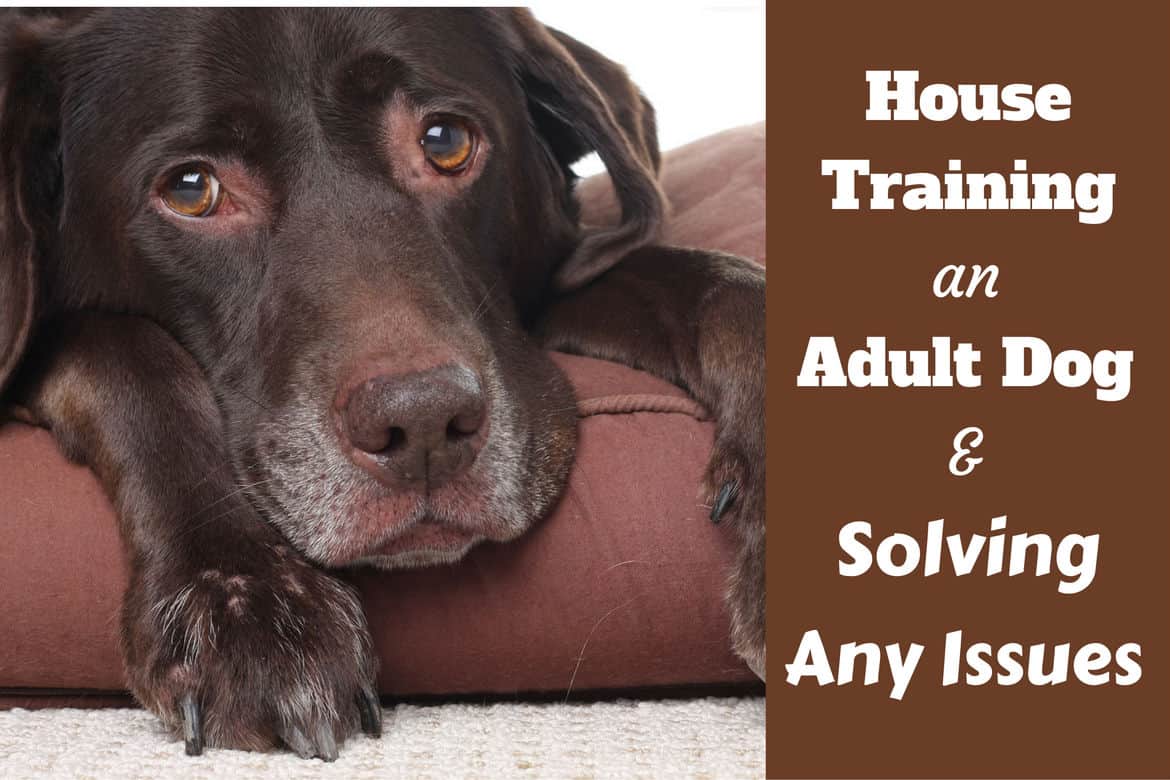
When an adult dog starts to potty in the home when they didn’t before, there are many possible reasons why.
It could be triggered by medical issues, changes in their life and environment or one of many different behavioral reasons.
The situation calls for careful investigation and a solution designed to tackle the precise cause of the issue.
Or maybe you have a newly adopted dog? They might have spent their entire life outside, or locked in a kennel 24/7?
Maybe house training began yet was never fully completed? Or perhaps they’ve never been house trained at all?
If so, you may have a dog that’s come with years of bad habits, deeply ingrained that you now have to correct.
While old habits can sometimes be hard to break, and older dogs don’t learn as quickly as puppies, you CAN teach an old dog new tricks and you can certainly train them acceptable toilet habits.
This article will show you how.
Start With The Techniques To House Train A Puppy
Regardless of the reason for your dog eliminating in your home, you should start by using the same techniques and methods used to house train a puppy.
This means feeding to a schedule, supervising closely when inside your home to intervene and correct mistakes, visiting the bathroom spot often and all the other methods and techniques at a house trainers disposal.
This is because the more mistakes you allow your dog to make in your home, the harder it will be to train the behavior out of them.
And the more you can praise them for doing the right thing, the quicker they learn what it is you expect of them.
For a detailed guide on general house training tips and techniques that you should use in all cases, please see my guide:
But you should be aware that with an adult dog:
Often, House Training 101 Just Isn’t Enough!
Most of the time there is an underlying issue that’s causing your dog to eliminate in the home.
The inappropriate toilet habits may not be the problem, but a symptom of something else. It’s the underlying issue that needs addressing and then the inappropriate toilet habits will disappear with it.
The rest of this article will help you to investigate and identify any such underlying issues, then show you how to treat it.
Your plan should be to follow the advice in the rest of this article IN ADDITION to my puppy house training advice. This will give you the greatest chance at finding success in the shortest time possible.
A Note On House Training Newly Adopted Dogs
When you adopt a dog through a rescue organization, they will tell you if they’re house trained or not. With a bit of luck, they will be.
Yet when you get you home, it might seem as if they’ve not been house trained at all! You might feel you’ve been told a pack of lies, but usually there is a far more logical reason.
Your dog has just been through a highly stressful time with a 100% change of every little thing in their life and they need time to adjust.
They will have a new family, a new home, new schedules and routines, a new diet, a whole new environment. This is highly stressful which often leads to house training mistakes.
Therefore, before you try to identify house training problems with any new dog, you should first apply the advice from my guide to house training a puppy for a couple of weeks.
Otherwise you could be looking for issues where there are in fact none and your newly adopted dog just needed time to settle in.
Finally, for the first few days of having your new dog home, taking a few days off work to completely dedicate yourself to the process and helping them to settle in is of massive benefit.
This is something that comes highly recommended.
Investigating The Cause Of Your Adult Dog’s House Soiling Issue
There are many things can lead to an adult dog urinating or defecating in the home. So to solve the issue, you first need to spend some time investigating the cause. The 4 areas you want to look into are:
- Medical reasons
- Dietary reasons
- Changes in the dog’s life or environment
- Behavioral reasons
With careful observation and a little thought, you will be able to determine exactly why your adult dog is pottying in the home.
This is true for both scenarios, whether it’s a newly adopted dog or your previously house trained dog whose toilet habits have suddenly changed.
So let’s discuss in some detail the 4 areas you need to look into.
Rule Out Medical Issues Before You Do Anything Else
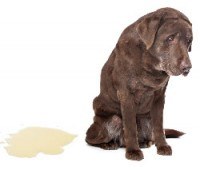
With any adult dog that’s soiling in the home, getting their health checked by a vet is the first thing you should do.
Many people straight away blame bad behavior but the truth is there are so many medical problems that can lead to a dog being unable to control their toilet habits that health is more likely to blame.
And if a medical issue IS to blame, no amount of training will help.
In fact with some issues, the dog may not even know they are leaking themselves, maybe even doing so in their sleep!
Some common medical problems responsible for inappropriate toilet habits are:
- Urinary tract infection
- Diabetes
- Kidney disease
- Bladder infections
- Incontinence due to ageing
- Dementia / cognitive dysfunction
- Inflammatory bowel disease
- Intestinal parasites
- Gastrointestinal upset
- Arthritis (extreme pain through movement can make a dog reluctant to move)
- Glandular or hormone related problems
- Side effects of some medications
There are many more besides.
So start your problem solving with a full examination by your vet, including urine and stool sample tests.
And make sure you discuss any medication your dog is receiving so they can check if this is part of the problem.
If your vet rules out medical issues as a likely cause then you should move on to investigating dietary reasons.
Check For Issues Around Diet And Food
A change in diet, low quality food and developing allergies are sometimes to blame for inappropriate toilet habits. Let’s take a look at these one by one:
A Change In Diet
Domestic dogs suffer stomach upset with remarkable predictability following any drastic change in diet. So if you’ve recently changed the brand or type of food you’re feeding, this could be to blame.
You should switch back to your dog’s old food and make the change over more slowly, adding some new to the old in increasing proportions, making the switch over roughly 10 days.
Not only this, but if you know your dogs ‘natural rhythms’ and have a routine potty schedule, a different food can dramatically alter this.
Some commercial foods are lower quality, with indigestible fillers. Others are very dry forcing a dog to drink more. Both these facts lead to producing more stools and having to potty more often.
Your dog may have needed to potty just 2 or 3 times a day on their old diet, but with the new food might need 4 or 5.
So you may have to design a new schedule to meet their new needs due to the change in diet. (Or better still, go back to a higher quality food!)
Food Allergies And Sensitivities
Much like us, dogs can develop allergies and sensitivities to food that result in an upset digestive system, soft stools, an increase in bowel movements and sometimes impossible to hold diarrhea.
The most common foods that dogs become sensitive to are: Beef, chicken, fish, lamb, dairy, wheat, corn and yeast…though luckily normally just one or two from the list!
To identify food allergies, look for accompanying symptoms such as itchy skin on their face, forelegs, armpits, feet and the anus. Recurring ear infections, excessive scratching and hair loss are further signs.
If you see any of these symptoms alongside changing toilet habits, a food allergy could be to blame and you should seek the advice of your vet who can offer dietary advice and a plan of action going forward.
For further information and advice on food allergies, please read Food Allergies and Food Intolerance from PetEducation.com
Table Scraps And Human Foods

Feeding a dog tables scraps, or other ‘human foods‘ can cause digestive upsets, soft stools and diarrhea which in turn can lead to there being ‘accidents’ in your home.
Even if you’re following good advice by not feeding table scraps and the odd treat yourself, do you really know if other people are doing the same?
Your children, partner, other residents in your home or even visitors could be slipping your dog bits of food that’s contributing to an issue.
You should also remember how it’s possible for your dog to eat things they find while out on a walk such as food from trash and animal carcasses.
Remind everybody of the ‘no human food rule’, and be extra vigilant watching your dog when out on walks to make sure they’re eating only what’s given at proper meal times.
Have There Been Changes In Your Dogs Life Or Environment?
If your vet passes your dog with a clean bill of health, and you’re certain you can rule out dietary reasons, the next area to investigate is possible changes in your their life or environment.
Changes In Your Dogs Environment
Dogs connect their behavior with the environment they learn it in, meaning if they learn a command or behavior in one environment, it doesn’t necessarily mean they can take that learning and apply it in another.
To a dog, hearing ‘SIT!‘ in your living room is NOT the same as hearing ‘SIT!‘ in the pet store.
They may well oblige every time in your home, but completely ignore the command in the pet store. They don’t know what ‘SIT!’ means in the pet store because they didn’t learn it there.
For similar reasons, from dramatic changes like moving to a new home, to more subtle things such as changing the fragrance of the air freshener you use, changes in your dogs home environment can result in changes to their behavioral patterns.
Any change in what they see, hear or smell in their environment, no matter how large or small, can result in a change in behavior.
So If your dogs starts to potty in the home very suddenly, take a good look around to see if anything has noticeably changed.
Treatment
Though the most crucial time for socialization during puppy-hood will have passed, it’s never too late to socialize your dog to everything they will encounter in life.
This will help them to develop greater confidence in all surroundings and the ability to generalize the things they know and learn to all environments.
But mainly, as long as the change you’ve identified as the cause is permanent, the cure is simply to allow your dog some time to adjust.
During this period, follow house training tactics to keep your house clean and prevent bad habits forming.
A Change In Schedule Or Routine
Similar to a change in environment, a change in your dog’s schedule or routine can result in a change with their toilet habits.
They really are creatures of habit and their mind and body thrive best when living to routines.
They get used to eating and eliminating at roughly the same times every day and come to expect these times.
So if there’s any change to when they are fed or taken outside to potty, they might not adjust too easily which can lead to mistakes.
Treatment
It’s a case of allowing your dog time to adjust to the new routine and following standard house training advice in the mean time.
If the change was dramatic you can help your dog to adjust more successfully by going back to the previous routine and making the change more slowly, going from the old schedule to the new one by moving in 10 to 20 minute steps each day or two.
Is Your Dog Potentially Stressed?
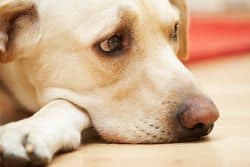
Stress can lead to a change in toilet habits, and many things can lead to a dog feeling stressed.
Have you recently given birth? Got a new pet? Has a pet of yours recently passed away? A member of your household gone from their lives? Do you have guests staying over? Is somebody in your home ill or injured?
If the cause of stress is something new appearing in a dog’s life, some take to urinating on the strange new things to make them smell more familiar. Things such as a guests luggage or a new pet’s or baby’s bedding.
In the case of a missing loved one…pet or human…the behavior will usually be accompanied by your dog acting anxious or depressed. It’s something you should look out for.
Treatment
There are a few things you can do to help relieve your dogs stress. A healthy diet, lots of exercise, loads of attention and love, all the things that help a human with stress can generally be applied to your dog.
As with most things, it’s also a case of allowing them time to adjust to the changes and following house training techniques to keep your home clean in the mean time.
Behavioral Causes Of House Soiling
If there are no underlying medical issues, no dietary issues and you’re unable to identify any changes in your dogs environment that may have triggered a change in their toilet habits, the final area to investigate is behavioral causes.
In order to identify behavioral issues it often helps to keep a written diary of the times your dog urinates or defecates in your home. You do this in the hope that a pattern emerges and you can pin-point the reason.
Things you would record are who was present, what was happening in the environment, your dog’s behavior leading up to, during and after the event and so on.
If your dog toilets in your home during your absence you should video record them so you can see exactly what’s going on around the time of them pottying.
The possible behavioral reasons for a dog toileting in the home are:
- Separation anxiety
- Urine marking
- Submissive / excitement urination
- Surface preference
- A dislike of eliminating in cold or rainy conditions
- Fear of loud noises, thunder and fireworks
- Lack of or incomplete house training in their lives
Being able to identify the above behavioral problems is extremely important because pottying in the home isn’t the real problem here, it’s merely the symptom. So to cure it you have to treat the underlying behavioral issues.
This calls for precisely targeted actions to be taken and only when you’ve tackled and cured the behavior issue can you ever hope to have a fully house trained dog.
So let’s look in turn at each of the previously mentioned behavioral issues.
Separation Anxiety
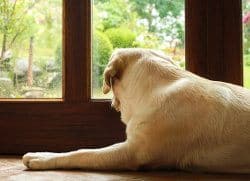
If your dog soils in the home only when you leave them alone, it could be a sign of separation anxiety.
The way to investigate this is to record a video of your dog from before the time you prepare to leave right through and past the time they toilet in your home so you can check on their behavior.
A dog suffering this condition will show any of the following behaviors when left alone:
- Barking
- Whining
- Howling
- Pacing
- Scratching at doors and windows
- Panting profusely
- Destructive behaviors (destroying household items)
- And of course, urinating and defecating
Note that it’s common for a dog to learn their owners behavior leading up to leaving, such as putting on shoes or picking up car keys.
And when they see these behaviors, can become anxious even before they’re left alone. The fear of knowing it’s going to happen is enough to cause anxiety.
So to investigate this as a possible cause, observe your dog’s behavior during the build up to you leaving and video their behavior during their time left alone.
Treatment
Treating a dog for separation anxiety requires teaching them to be happy with, or at least tolerant of time spent alone. This is done by way of systematic desensitization and counter-conditioning.
This involves exposing your dog to ever-increasing time alone, starting with very short separations that do not result in anxiety, slowly increasing the time of separations over many weeks and months.
It’s a complicated task that requires a great understanding of the dogs emotions and reactions, skill to carry out the training and patience and dedication to see the task through.
It’s recommended that the help of a professional is sought to treat separation anxiety as working through it is no easy task.
A professional trainer can design a specific treatment program tailored to your individual dog while training you in how to treat the condition. ‘Train the trainer‘ as it were.
This is extremely important because separation anxiety severely lowers a dogs quality of life and can even lead to them harming themselves.
Successful and effective treatment is of utmost importance so you will want to get it right.
For a good overview of separation anxiety, please read: Separation Anxiety from the ASPCA, and linked to from that article, the techniques of Desensitization and Counter-conditioning, two methods used during treatment.
Urine Marking
Urine marking, also known as scent marking, is typified by a dog raising their leg to urinate high on vertical objects.
It doesn’t come from a need to urinate, but because they want to leave a small amount of their scent to lay claim to a territory, or to leave a ‘calling card’ to identify themselves to other dogs.
Sometimes the behavior can come from a feeling of anxiety around strange new objects in their environment.
They will sometimes through anxiety feel the need to scent mark unfamiliar items such as a new pets bedding, or the suitcase of a guest in your home.
You can distinguish urine marking from standard urination by the amount that is produced. Urine marking is just small little squirts in comparison to a full emptying of the bladder.
Although urine marking is most often seen in intact males, it can also be seen in neutered males and even the occasional female too. It’s just a lot less likely, not impossible
Treatment
If the marking stems from anxiety, socializing your dog to the sight and smell of the new object will help, as will forming positive associations with it by regularly placing treats nearby and spending time playing around or even with it.
You might also want to try a ‘synthetic pheromone diffuser‘ that can have a calming effect on your dog, reducing the anxiety they may be feeling.
Also, as many as 2 in 3 intact dogs stop the behavior after neutering so this treatment is worth considering.
Though you should read up on the pros and cons of the procedure first before taking such drastic action: The Pros and Cons of Neutering Your Male Dog
Finally, follow common house training methods, cleaning away all traces of previous scent marking, constantly supervising your dog to interrupt and correct their marking and so on.
Eventually they should learn it’s unacceptable.
Submissive Or Excitement Urination
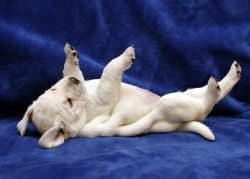
You can identify the issue as submissive urination if your dog urinates when somebody approaches, stands tall over them or starts to verbally or physically punish them.
Other submissive body language will also be displayed such as cowering low, ears pinned back, turning their body sideways and avoiding eye contact, maybe even rolling over to expose their belly.
Excitement urination is different to submissive urination in both the emotion the dog is feeling and the events that lead to the problem.
Excitement urination will occur with a dog who gets overly excited.
Usually it occurs when a family member returns home from a day away, when meeting new people or when somebody showers them with praise and affection.
Both excitement and submissive urination are most regularly seen in puppies and young female dogs, though it can happen in dogs of any age or gender.
It appears mostly in timid dogs, those that are overall very submissive, somewhat fearful and lack confidence in themselves.
Treatment
For submissive urination, the treatment is to avoid verbal and physical punishment or anything that makes your dog feel threatened or dominated.
Secondly, you need to build their confidence through lots of socialization. Expose them to positive life experiences in all kinds of environments, with all types of people and other animals present.
As their confidence grows over time, their fear levels will fall and the problem will slowly go away.
To treat excitement urination you need to prevent your dog from getting over-excited.
This means keeping greetings subdued and learning the signs of over excitement so you know when to back off and calm things down during play.
Surface Preference
If your dog only seems to potty on a particular surface, they may have developed a preference for a single surface type to use as a toilet.
This can happen if they’ve been forced to eliminate on a single surface type for most of their lives, such as newspaper in a kennel or always on a concrete yard.
But usually, a dog will develop a preference for the soft feel of grass under their feet and unfortunately a deep shag pile carpet is very similar.
So you may find your dog doesn’t eliminate when you take them outside to a concrete yard, but they do so right away when back on your lush carpet which feels to them like grass.
Treatment
The best advice I’ve seen is two-fold.
Firstly, teach your dog to eliminate on command so they know you want them to go. However, this alone will not be enough to overcome their preference. So…
Secondly, combine the surface your dog prefers with the one you want them to go on, slowly switching them over from one surface to another by mixing the two.
As an example, let’s say you want your dog to eliminate in your concrete back yard, but they will only eliminate on grass and your carpet (because your carpet feels like grass.)
You can buy a couple of rolls of turf and lay them over the concrete for them to use as a toilet.
Then reduce the thickness of the grass by cutting it. Then swap the turf for just grass cuttings. Next reduce the grass cuttings bit by bit until eventually there is none and your dog is happy to eliminate on concrete.
You can use the same technique with whatever surface your dog is refusing to use as a toilet while following the usual house training techniques to discourage pottying inside.
A Dislike Of Eliminating In Cold Or Rainy Conditions
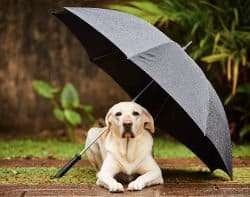
Some dogs hate to toilet outside in cold and wet conditions, particularly small breeds and those with single short coats.
It’s not commonly seen with the double coated, sturdy Labrador, but it isn’t completely unknown.
If your dog normally pottys outside without any problems but refuses to during cold conditions, only to eliminate when back inside your home, this is a probable cause.
Treatment
You can buy a purpose made coat for your dog or puppy, as well as thermal boots. These will help to fight off the cold and make them happier to be outside.
Secondly, you can take your dog to a sheltered area of the garden, or perhaps even build a roof over the area you’ve set aside as their bathroom spot.
This will protect them from the wind, and keep them sheltered from the rain and snow. This will go a long way to helping them feel more comfortable and hopefully happy to go.
Next, make sure you go out and stay outside with them! Don’t throw them out and come back in yourself.
They will just pine to come in after you, and maybe even feel hard done by watching you all warm though the window while they freeze their little tail off outside.
Another thing that will help is teaching them to potty on command so you can clearly communicate what it is you want them to do.
Finally, don’t forget to watch them like a hawk when inside to prevent as many accidents as possible, and take them outside very frequently so you can praise them for doing the right thing.
This will encourage them to do the right thing.
Fear Of Loud Noises, Thunder And Fireworks
Otherwise perfectly confident and fearless dogs can be so overcome with fear during a thunderstorm or firework display that it leads to urination or defecation.
Fear of thunderstorms and fireworks (and other loud noises) can progress into true phobias that lead to urination and / or defecation through feelings of intense fear.
Treatment
The most effective treatment is desensitization to loud noises. This involves playing a soundtrack of the thunder or fireworks at volumes so low that it doesn’t provoke any fear, and you treat and play with your dog to associate the sound with good things.
This needs to be practiced daily, with the sound being increased only marginally every week or so, stopping and going back to a lower volume if your dog shows any sign of fear.
The program needs to be followed for many months and the hope is in time, your dog becomes desensitized to the sound and far less fearful.
Secondly, some people have had success with pheromone therapy which involves nothing more than plugging a Dog Appeasing Pheromone (DAP) diffuser into the wall and turning it on.
There’s research proving its effectiveness and it reportedly helps as many as 50% of dogs, reducing the level of anxiety they feel.
Finally, you should make sure your dog has a safe place to head to if they wish. Many dogs will have a place they see as their den, where they feel the safest and most secure.
If you use one this will be their crate, though some satisfy their denning instinct by lying under a table, or between close-fitting furniture.
Make sure if they have such a place that they have access to it but aren’t locked in.
Let them come and go so they feel they have a choice because if they’re either kept from or locked in their den, they may feel more anxiety than they otherwise would.
Lack Of Or Incomplete House Training In Their Lives
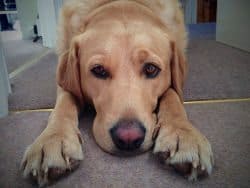
Some unfortunate dogs will have spent their entire lives outside and never been house trained at all. Others will have had incomplete house training and this is a very common reason for dogs being given to rescue organizations in the first place.
A dog with zero house training experience will have no idea they aren’t supposed to potty in the home. They might eliminate whenever they feel the urge, no matter where they are.
An incompletely house trained dog will only occasionally make a mistake while mostly being clean, usually in specific circumstances. For instance they will sneak off alone to potty, or not know how to ask to go outside.
Treatment
You house train an adult dog in much the same way as you do a puppy. So please follow the general tips and guidelines written in my guide to house training a puppy which you can find by clicking here .
Compared to house training a puppy, house training an adult dog has a mixture of pros and cons, some making the process easier, some harder.
Training an adult dog is easier because they have more bodily control, a stronger bladder and a stronger bowel than a puppy so they’re better equipped to learn more quickly.
This results in fewer trips outside for you and no need (hopefully) to get up during the night.
However, house training an adult dog can be more challenging if they have many months or years of bad habits that you now have to break.
Just follow a structured house training program and do all you can to help them learn. Be patient, understanding of their position and dedicated to the cause. Eventually any dog can be house trained.
Conclusion
As just discussed, there are many reasons why an adult dog might urinate or defecate in the home.
Medical and dietary reasons are (hopefully) easily solved, changes in your dog’s life or environment need a little more work, while behavioral reasons can sometimes be challenging.
However, with some thoughtful investigation into finding the root cause of the issue, consistent management of the problem and appropriate training, no dog is beyond learning the toilet habits that you’ve chosen for them.
Also true is that the sooner you start, the sooner you can solve the problem and the longer you let bad habits continue, the harder they are to break. So get started right away.
If after following the advice in this article you’re struggling to find success or an appropriate plan of action to follow, the situation may be more complicated than you’re able to solve alone.
Then you must seek the help of a professional dog trainer or animal behaviorist who can assess the situation fully and design a custom training plan to suit your dogs specific needs.
My Complete House Training Program
This was the final part in my 12-part series where I’ve tried to provide all the guidance you could possibly ever need and covered everything I can think of for you to successfully house train your puppy or adult dog.
(Note: The information applies equally well to dogs of all breeds and not just Labradors.)
Please see the entire series linked to below:
- Part 1: House Training – The Ultimate Guide
- Part 2: Basic Need To Know Facts Before You Start
- Part 3: The Mindset And Approach You Must Take
- Part 4: House Training Products, Supplies And Equipment You will Need
- Part 5: Accidents Happen: How To Remove Pet Stains And Odors
- Part 6: Feeding Choices Make A Massive Difference
- Part 7: How To Use A Crate To House Train A Puppy
- Part 8: House Training WITHOUT A Crate: Constant Supervision
- Part 9: How To Paper Train Your Puppy Or Dog The Easy Way
- Part 10: Umbilical Cord House Training: What is It? How Does It Work?
- Part 11: How To House Train A Puppy
- Part 12: How To House Train An Adult Dog – And Solving Common Issues
External Resources
For further reading on how to train an adult dog, please see the following articles I read during the research stage of my article:
- House Training Your Adult Dog – From pets.WebMD
- House Training An Adult Dog – From AllDogsGym
Top Picks For Our Dogs
- BEST PUPPY TOY
We Like: Calmeroos Puppy Toy w/ Heartbeat and Heat Packs - Perfect for new puppies. Helps ease anxiety in their new home. - BEST DOG CHEW
We Like: Bones & Chews Bully Sticks - All of our puppies love to bite, nip, and chew. We love using Bully Sticks to help divert these unwanted behaviors. - BEST DOG TREATS
We Like: Crazy Dog Train Me Treats - One of our favorite treats for training our service dog puppies. - BEST FRESH DOG FOOD
We Like: The Farmer's Dog - A couple months ago we started feeding Raven fresh dog food and she loves it! Get 50% off your first order of The Farmer's Dog.
For a list of all the supplies we get for our new service dog puppies check out our New Puppy Checklist on the PuppyInTraining.com blog.
8 comments
What a great article with so much helpful information! One thing we encounter quite often is people who have older dogs who do have health issues and begin to go to the bathroom in the house. While the health condition might not be avoidable, repeat accidents can be somewhat controlled by properly cleaning areas where an incident occurred. Because dogs urinate based on scent, they may continue to go regularly in a spot where an accident occurred. If a spot is not cleaned and the odor not completely removed, they may continue to go in that spot simply because they smell urine in the carpet.
Another important piece to that is very often vinegar is suggested for cleaning pet stains. However vinegar has an acidic base with a pH level similar to the pH level of the acid base in urine. As a result, the odor of vinegar can cause a dog to pick up the scent and confuse it for urine, in turn, instinctively thinking that is a spot where he/she should be going to the bathroom.
It is very important that when cleaning areas affected by urine, it is done so in a manner to completely remove and deodorize the odor. This is where Genesis 950 is helpful in removing pet stains and odors. As a green cleaner it is also safe for pets, unlike many household cleaners which can affect blood cells, respiratory systems and more.
Very valid points that I do repeat throughout my guide. Cleaning up THOROUGHLY after accidents is essential!
This is a great article.. I have a 13th month old dog that was born blind, the first 10 months of his life was spent living in a local veterinary establishment, during this time he was homed three times and returned three times… I decided to take him on with the full intention of giving him a loving home… My problem, I’m having a rough time trying to potty train him outside, he seems a ‘marker’ and both indoors and outdoors seems ok with him, I have tried everything I can think of, I’ve purchased so many products, I’ve crated him, I attached him to myself, he cannot live outside its way too hot here in Florida. I’ve bought belly bands which helped but he has a really long thick coat so it gets matts when I use these…
I’ve gone back to enlarging his pen and adding one of my other dogs as company and a one and a half hour break outside, please wish me luck, I hope this works… Any other suggestions would be very welcome.. One things for sure, he’s never to be re-homed again, I will crack this… Sheila.
Hi Sheila,
I’m afraid we have no experience of training a blind dog and the unique challenges that it must present, so we have no specific advice I’m afraid. It would be worse to give you guidance that we guess at, for it might be wrong and would be a waste of your time and resources.
Have you tried speaking to some local, professional dog trainers? See if they have experience of training a blind dog and then hiring that person? I think it’s a great idea because – without knowing, this is just a guess – I would think a blind dog needs very specific training techniques and strategy’s to help them along.
“develop allergies and sensitivities to food that result in an upset digestive system..” This is something crucial by the way, the mistake the people just don’t realize or just take for granted and hope the dogs can eat whatever possible.In a nutshell i would say, different type of food only suitable for certain dogs only. Adult dogs should stick with adult dogs product. Do not mix around with puppy food, or senior dog foods. But this is something depend on various breed and some breed very sensitive if the diet has been change suddenly.
Hello,
I will try to follow your advice. Then I will write whether this article has helped or not. But I’m glad I found your article. A lot of interesting information.
Nice one! Thank you for posting the Dog care related articles. It is informative and helpful to us like dog owners and beginners both. I have adopted the adult dog last few months before and sometimes I confusing related to her food and routine.
you have failed to cover dogs that become afraid to toilet!